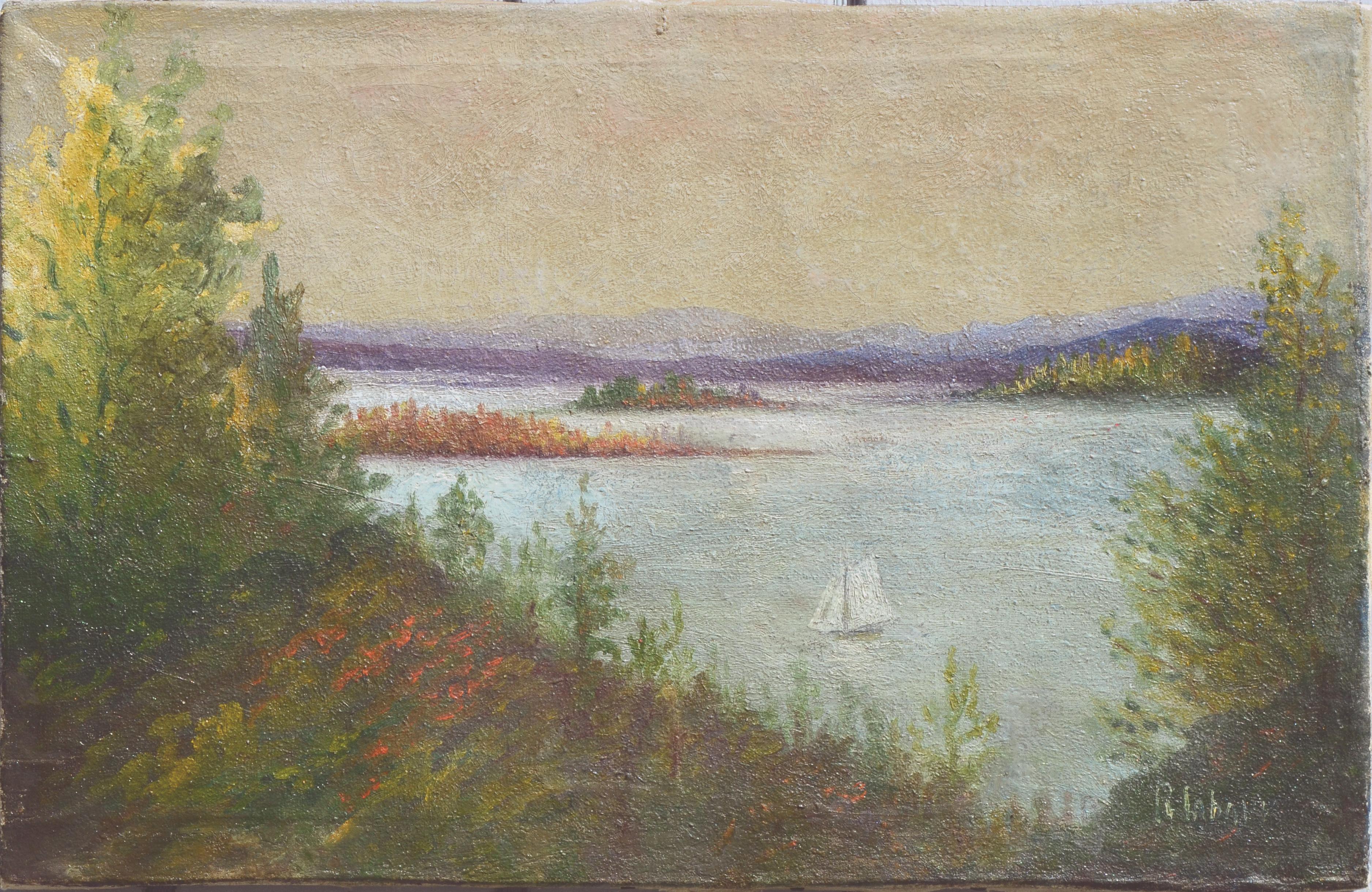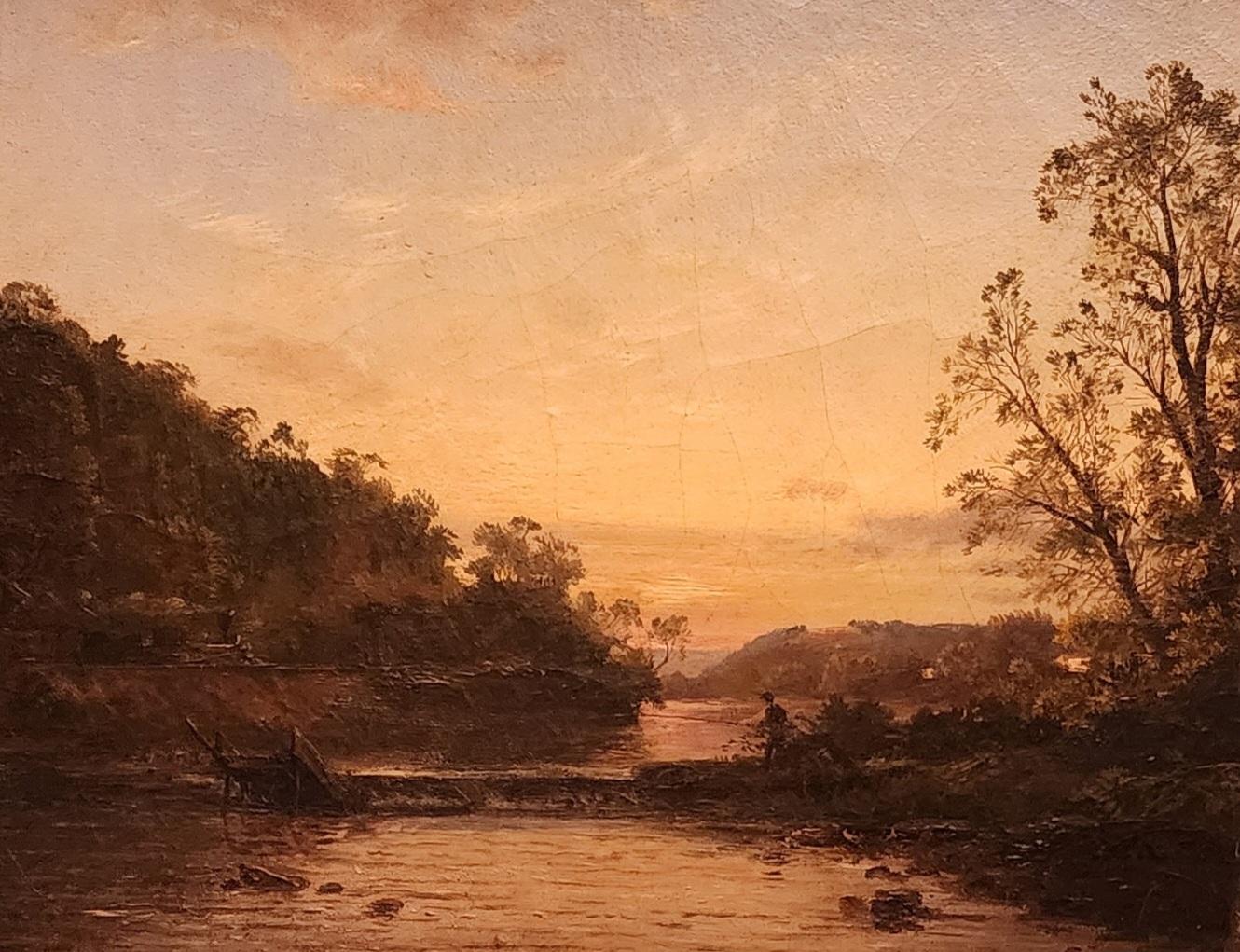Items Similar to A Day in November, 1863 by James MacDougal Hart (American: 1828–1901)
Want more images or videos?
Request additional images or videos from the seller
1 of 6
James McDougal HartA Day in November, 1863 by James MacDougal Hart (American: 1828–1901)1863
1863
About the Item
A prominent 19th century landscapist, Hudson River School painter James McDougal Hart's (1828-1901) A Day in November, 1863 is oil on canvas and measures 10.5 x 18 inches. The painting is signed by Hart and dated 1863 at the lower left. The work is inscribed with the title, and dated 1863 on the verso. The work is framed in a period appropriate frame and ready to hang.
Provenance: Tom Colville, New Haven, CT William Union, Worcester, MA Mr. and Mrs. Craig C. Halvorson, Brookline, MA (acquired from the above January 16, 1982)
Prominent amongst the second generation of Hudson River School painters, James McDougal Hart is known for his refined and intricately crafted pastoral scenes, often featuring grazing cattle. Born in Kilmarnock, Scotland in 1828, Hart immigrated with his family to Albany, New York when he was just two years old. His older brother, William Hart (1823–1894), and younger sister, Julie Hart Beers (1835–1913), also went on to become accomplished landscape painters. James’ future wife, Marie Theresa Gorsuch, was a still life painter, and their three children, Robert
Gorsuch Hart, Letitia Bonnet Hart, and Mary Theresa Hart, all grew up to be painters as well.
James Hart began his career, as had William, in a sign and carriage painter’s shop. Unlike his brother, James returned to Europe at the age of twenty-two to receive academic training. He studied briefly in Munich, and for three years with Johann Willhelm Schirmer (1807–1863) at the Düsseldorf Academy, a center of realist pedagogy that was equally influential for fellow Hudson River School painters, Worthington Whittredge (1820–1910), Eastman Johnson (1824–1905),
Albert Bierstadt (1830–1902), and William Stanley Haseltine (1835–1900).
Returning to the United States in 1853, Hart established his first studio in Albany. A few years later, he settled permanently in New York City, later moving to Brooklyn. In the 1870s, he and his brother opened studios in Keene Valley, New York, in the heart of the Adirondacks. Hart was elected an Associate of the National Academy of Design in 1857 and a full member in 1859, exhibiting his work there consistently over the next forty years, and serving as its Vice President from 1895 to 1899. He also exhibited at the Brooklyn Art Association, the Pennsylvania Academy of the Fine Arts, the Boston Art Club, the Mechanics Institute in Boston, the Corcoran Gallery of Art, the Art Institute of Chicago, the Centennial International Exposition of 1876 (the first official World’s Fair in the United States, held in Philadelphia), and the Paris Exposition of 1889.
In 1867, prominent art critic Henry Tuckerman observed that “an exquisite truth and grace [are] characteristic of his [Hart’s] pencil,” and praised his Woods in Autumn as “one of the finest contributions lately made to the list of American successes in this field of art.” Today, Hart’s paintings are in the collections of the Metropolitan Museum of Art; the Brooklyn Museum; the Museum of Fine Arts, Boston; Harvard University’s Fogg Art Museum; the Smithsonian Museum
of American Art, Washington, D.C.; the Corcoran Gallery of Art; the Walters Art Museum, Baltimore, Maryland; and the Thyssen-Bornemisza Museum, Madrid, among others. A Day in November, 1863 is an accomplished essay by Hart which carefully notes his interest in country life. A mother and child ride an ox-drawn wagon of logs while the father steers the way.
The artist’s lessons in careful draftsmanship are reflected both in smaller details of the scene such as the perspective of the wagon’s wheels as well as in the whole shaping of the composition such as the lines of the stone fence and the white steeple spire and village buildings tucked into the nearby hills. The painting was most likely executed in the Catskill region as it is inscribed by the artist with a New York location.
- Creator:James McDougal Hart (1828-1901, American)
- Creation Year:1863
- Dimensions:Height: 10.5 in (26.67 cm)Width: 18 in (45.72 cm)
- Medium:
- Movement & Style:
- Period:
- Condition:
- Gallery Location:New York, NY
- Reference Number:1stDibs: LU2151213160852
About the Seller
5.0
Vetted Seller
These experienced sellers undergo a comprehensive evaluation by our team of in-house experts.
Established in 2004
1stDibs seller since 2022
- ShippingRetrieving quote...Ships From: New York, NY
- Return PolicyA return for this item may be initiated within 14 days of delivery.
More From This SellerView All
- Hudson River Landscape, 1865 by Johann Hermann Carmiencke (American, 1810-1867)By Johann Hermann CarmienckeLocated in New York, NYPainted by Hudson River School artist Johann Hermann Carmiencke, "Hudson River Landscape" 1865 is oil on canvas, measures 12 x 18 inches, and is signed and dated 1865 at the lower ri...Category
19th Century Hudson River School Landscape Paintings
MaterialsOil, Canvas
- Gordon Setter in a Landscape by Otto Norquist (American: 1859-1906)Located in New York, NYOtto Norquist (1859-1906) "Gordon Setter in a Landscape, 1890" Oil on canvas 22 x 27 inches Signed and dated 1890, lower right Otto Norquist was born in...Category
Late 19th Century Hudson River School Landscape Paintings
MaterialsOil, Canvas
- Woodland Waterfall by John Frederick Kensett (American: 1816-1872)By John Frederick KensettLocated in New York, NYJOHN FREDERICK KENSETT (1816-1872) Woodland Waterfall Oil on canvas 14 x 12 inches Signed lower rightCategory
19th Century Hudson River School Landscape Paintings
MaterialsCanvas, Oil
- Hudson River Inlet, 1885 by American artist Frank Anderson (American: 1844-1891)By Frank AndersonLocated in New York, NYHudson River Inlet, 1885 by Hudson River School artist Frank Anderson (1844-1891) is oil on canvas. The work measures 15.13 x 24.25 inches ...Category
19th Century Hudson River School Landscape Paintings
MaterialsCanvas, Oil
- Seascape by George Herbert McCord (American, 1848-1909)By George Herbert McCordLocated in New York, NY"Seascape," by Hudson River School artist George Herbert McCord (1848-1909) is oil on canvas and measures 18.07 x 30.13 inches. The work which comes from a private collection in Birmingham, Alabama is signed “G.H. McCord A.N.A.” at the lower left. The work is framed in a beautiful, period appropriate frame, and ready to hang. A member of the second generation of Hudson River School painters, George Herbert McCord is known for his atmospheric landscape and marine paintings which capture a variety of locales and are executed in a variety of media—including oil, pastel, and watercolor. McCord was born in 1848 in New York City, where he lived and worked his entire life. After 1883, he kept an additional studio in Morristown, NJ. McCord traveled throughout North America, painting in the Berkshire, Adirondack and Laurentian mountain ranges, the Hudson River Valley, the Coast of New England, the Upper Mississippi, and Florida, which had become popular among Eastern vacationers. He was among a select group of artists commissioned by the Santa Fe Railroad to paint the Grand Canyon, and also participated in a special painting excursion to the Erie Canal. His travels in Europe were equally expansive, taking him to England, Scotland (having been commissioned by Andrew Carnegie to paint the scenery around his castle there), France, the Netherlands, and Italy. McCord was well-educated, having attended Claverack College amidst the Catskills in Claverack, NY, which provided instruction in classical, French, German, English, music, painting, military, commercial, telegraphic and agricultural studies. He also studied with the accomplished painter and inventor of Morse code, Samuel F.B. Morse, and with the Scottishborn landscape painter, James Fairman. McCord was active in numerous art clubs and institutions in New York, including the National Academy of Design, which elected him an Associate member in 1880, the American Watercolor Society, the Brooklyn Art...Category
19th Century Hudson River School Landscape Paintings
MaterialsOil, Canvas
- Landscape in the Hudson Valley by Worthington Whittredge (American, 1820-1910)By Worthington WhittredgeLocated in New York, NYHudson River School artist Worthington Whittredge's (1820-1910) Landscape in the Hudson Valley is oil on canvas and measures 11 x 19 inches. The work is signed by the artist at the l...Category
19th Century Hudson River School Landscape Paintings
MaterialsCanvas, Oil
You May Also Like
- Autumn Idle, Catskills, New York, October 23, 1885By Jervis McEnteeLocated in Missouri, MOAutumn Idle, Catskills, New York, October 23, 1885 By. Jervis McEntee (American, 1828-1891) Unframed: 11.5" x 16" Framed: 20.5" x 25" Jervis McEntee was a landscape painter, born in 1828 in the Hudson River Valley in Rondout, New York. It was said that 'Nostalgia may well have been McEntee's middle name", and that he, always attempting to stir emotions in his viewers, often attached poetry to his paintings when exhibiting them. At a time when the Civil War and its after effects caused great disruption in America, McEntee's work may have provided a visual escape for the more educated. His works are rich with the colors of autumn and winter, and he, who often painted in the Catskill Mountains, preferred smaller views rather than panoramas. Usually detailed and simple, his works often reflect a sense of loneliness. As a youngster, McEntee would play in his parents attic, pretending it was an art studio. An unsuccessful attempt at business led McEntee back into the art profession where he studied in New York City under the influence of Frederic E. Church, master of the Hudson River Style, and soon had a showing of his own in the famous Tenth Street Studio Building by 1855. In about 1858, Mr. and Mrs. McEntee hired English architect Calvert Vaux to build a studio next to McEntee's fathers house in Rondout. There Jervis would spend most of his summers, painting the nearby Catskill Mountains, and returning to the city during the winter. At the outbreak of the Civil War, McEntee enlisted in the Union...Category
Late 19th Century Hudson River School Landscape Paintings
MaterialsOil, Canvas
- Forest ClearingBy Roswell Morse ShurtleffLocated in Saratoga Springs, NYSigned lower left. Most noted for his paintings of forest interiors, Roswell Shurtleff settled in Hartford, Connecticut but spent his summers painting his signature works in the Adirondacks at Keene Valley, New York. He and John Lee Fitch successfully encouraged other artists to join them including Winslow Homer, J Alden Weir, James Smillie...Category
Late 19th Century Hudson River School Landscape Paintings
MaterialsOil, Canvas
- 19th Century Hudson River School Landscape after Richard GoodwinLocated in Soquel, CACharming Hudson River school antique oil painting of a sailboat on a lake, circa 1880-90. Signed "R. Labarr." after Richard LaBarre Goodwin...Category
1880s Hudson River School Landscape Paintings
MaterialsCanvas, Oil
- New England FarmLocated in Milford, NHA fine large landscape of a New England farm with cows, stone arch bridge, farmhouse and barns by American artist John White Allen Scott (1815-1907). Scott was born in Roxbury, MA and apprenticed with lithographer William Pendleton and later worked with Fitz Henry Lane...Category
19th Century Hudson River School Landscape Paintings
MaterialsCanvas, Oil
- Pleasant Thoughts oil painting by Arthur Fitzwilliam TaitBy Arthur Fitzwilliam TaitLocated in Hudson, NYThis painting is listed in the W.H. Cadbury and H.F. Marsh book Arthur Fitzwilliam Tait: Artist in the Adirondacks, Newark, Delaware, 1986, no.59.36t. It is hand-signed "AF Tait...Category
1850s Hudson River School Figurative Paintings
MaterialsOil, Canvas
- Fishing by the StreamLocated in Saratoga Springs, NYSigned lower rightCategory
1860s Hudson River School Landscape Paintings
MaterialsCanvas, Oil
Recently Viewed
View AllMore Ways To Browse
American Antique Shops
18c American
James Way
1901 Oil
James River
Hudson River School Inness
James Stone
James Brown Painter
James Hill
American School Hudson River
Scotland James
Hudson River Painters
Hudson River School New York
Hudson Valley School
Hudson Valley School Of
James Fellowes
Hudson Valley School Of Art
Baltimore Painters




